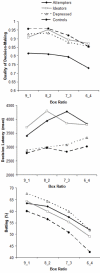Impairment in risk-sensitive decision-making in older suicide attempters with depression
- PMID: 21443349
- PMCID: PMC3115442
- DOI: 10.1037/a0021646
Impairment in risk-sensitive decision-making in older suicide attempters with depression
Abstract
Suicidal behavior is a potentially lethal complication of late-life depression. In younger adults, suicide has been linked to abnormal decision-making ability. Given that there are substantial age-related decreases in decision-making ability, and that older adults experience environmental stressors that require effective decision-making, we reasoned that impaired decision-making may be particularly relevant to suicidal behavior in the elderly. We thus compared performance on a probabilistic decision-making task that does not involve working memory ("Cambridge Gamble Task") in four groups of older adults: (1) individuals with major depression and a history of suicide attempt (n = 25), (2) individuals with major depression with active suicidal ideation but no suicide attempt (n = 13), (3) individuals with major depression without suicidality (n = 35), and (4) nondepressed control subjects (n = 22). There was a significant effect of group on quality of decision-making, whereby the suicide attempters exhibited poorer ability to choose the likely outcome, compared with the nonsuicidal depressed and nondepressed comparison subjects. There were no group differences in betting behavior. The suicide attempters differed in several aspects of social problem-solving on a self-report scale. Quality of decision-making was negatively correlated with the score on the impulsive/careless problem-solving subscale. These data suggest that older suicide attempters have a deficit in risk-sensitive decision-making, extending observations in younger adults. More specifically, older suicide attempters seem to neglect outcome probability and make poor choices. These impairments may precipitate and perpetuate suicidal crisis in depressed elders. Identification of decision-making impairment in suicidal elders may help with designing effective interventions.
(c) 2011 APA, all rights reserved.
Figures

References
-
- Bechara A, Damasio AR, Damasio H, Anderson SW. Insensitivity to future consequences following damage to human prefrontal cortex. Cognition. 1994;50:7–15. - PubMed
-
- Bechara A, Tranel D, Damasio H. Characterization of the decision-making deficit of patients with ventromedial prefrontal cortex lesions. Brain. 2000;123:2189–2202. - PubMed
-
- Beck AT, Beck R, Kovacs M. Classification of suicidal behaviors: I. Quantifying intent and medical lethality. American Journal of Psychiatry. 1975;132:285–287. - PubMed
-
- Beck AT, Kovacs M, Weissman A. Assessment of suicidal intention: the Scale for Suicide Ideation. Journal of Consulting and Clinical Psychology. 1979;47:343–352. - PubMed
-
- Beck AT, Steer RA, Beck JS, Newman CF. Hopelessness, depression, suicidal ideation, and clinical diagnosis of depression. Suicide and Life-Threatening Behavior. 1993;23:139–145. - PubMed
Publication types
MeSH terms
Grants and funding
LinkOut - more resources
Full Text Sources
Medical

